NORTH WALES COAST
RAILWAY: NOTICE BOARD
Rheilffordd arfordir gogledd Cymru: Hysbysfwrdd
27 October 2010
 Last issue
Last issue Archive
Archive Contributions and comments are encouraged: see the Contributions Page
This site is dedicated to all our regular contributors and supporters, and especially the all rail staff of North Wales.
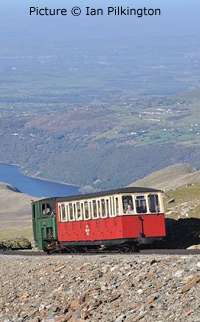
Forthcoming events
October 2010
Thursday 28 October Merseyside Railway History Group Keith Crabtree: Tornado, a steam locomotive for the 21st Century
29 - 31 October Merseyside Model Railway Society exhibition at the Pacific Road Arts Centre, Birkenhead. Trams will be in operation on the adjacent tramway.
November 2010
Monday 1 November RCTS Port Sunlight Steve Ollive: PLANDAMPF 94 Featuring standard and narrow gauge in East Germany and organised trips around Dresden and the Thuringer Forest
Tuesday 2 November North Wales Railway Circle Paul Hardy: Wait and See (a secret location?)
Friday 5 November Clwyd Railway Circle Gordon Davies - American Wanderings. - A selection of slides showing diesel, electric and steam trains in the USA working passenger and extremely long freight trains from the East to the West coast, photographed in the last 16 years.
Friday 12 November Altrincham Electric Railway Preservation Society
16MM CINÉ FILMS FROM THE 1970s a miscellany by Richard Greenwood
6-7 November. Llangollen Railway Poppy Train Service as part of the Remembrance festival - special guest engine possible.
Tuesday 9 November. 8E Association Chris Simon: ‘The Examination Quiz’.
Monday 15 November RCTS Chester Keith Crabtree: 60163 Tornado.Keith is from the A1 Steam Trust and will be giving a Power-point presentation on the history, building and operation of Tornado.
Tuesday 16 November North Wales Railway Circle Steve Morris: Brake Trials
Thursday 25 November Merseyside Railway History Group Geoff Morris: Steaming through the gauges in the 21st Century
See the Calendar page for more details.
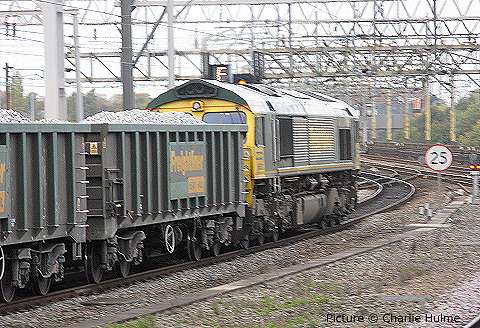
The new Penmaenmawr - Guide Bridge stone train heads on to Stockport viaduct at 16:45 on Wedneday 27 October. The wagons are coupled in pairs by semi-permanent bar couplers.
New freight flow
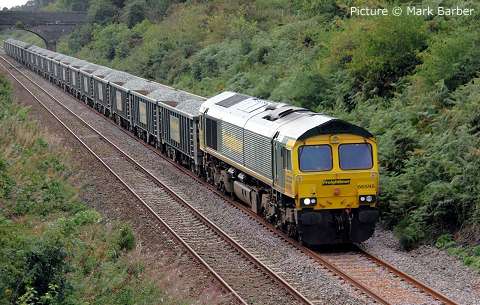
Not previously mentioned here (due to editorial incompetence) is the new contract awarded to Freightliner to haul stone from Penmaenmawr quarry to the Network Rail sidings at Guide Bridge four days a week for twelve months, staring on 10 September. Mark Barber's picture above shows the loaded train at Cuddington on 20 September. The train runs out and back from Guide Bridge, via Stockport, Northwich and Chester, as something resembling the following times: Guide Bridge 07:34, Chester 08:51, Rhyl 09:21, Llandudno Junction 09:37, Penmaenmawr arrive 09:50. Loaded train departs from the quarry sidings at 13:37, passing Llandudno Junction 13:57, Rhyl 14:20, pausing at Chester 15:04 - 15:12 and arriving Guide Bridge 17:11. As usual with freight trains, late or early running is possible, however - the train was noted at Edgeley Junction (Stockport) at 15:45 on 19 October.
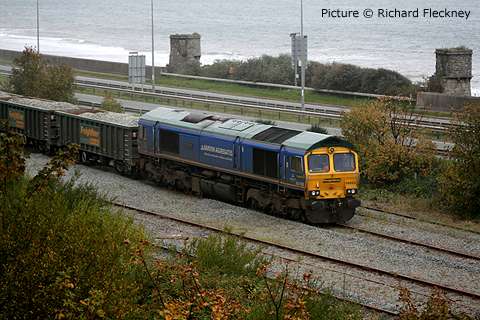
Bardon Aggregates livery on 66 623, seen in the quarry sidings on 18 October. (Richard Fleckney)
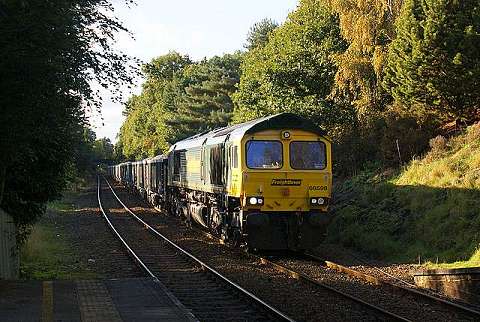
Geoff Morris writes: I wanted to try to photograph the new service in Delamere forest. Unfortunately the height of the trees means that the line is generally in shadow and so the best I could find (after a good deal of walking) was off the end of the platform at Delamere station. 66 598 is shown accelerating through the station with the loaded train to Guide Bridge on 20 October.
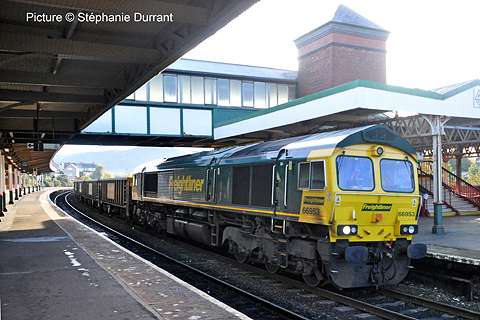
Llandudno Junction at 10:00 on Monday 25 October with 66 953 (Stéphanie Durrant)
Cambrian Coast ERTMS goes live
The new ERTMS signalling came in to use on 24 October, but only on the Harlech - Pwllheli section. However, passengers from 24-26 October are being carried in buses over this section (timetable) for 'essential Driver training' according to the Arriva Trains Wales website. More to this than meets they eye, perhaps, we hear rumours that drivers are not happy.

Meanwhile, the boffins have devised a solution to the problem of sun glare on the essential screen display in the cab that has been plaguing the ERTMS trials with Class 158 trains. It's a good old-fashioned anti-glare screen (who remembers them from the pioneering VDU days of the 1970s?) which pulls out and drops down over the normal screen when required, as shown in the action sequence above. (The newspaper demonstrates the effect, it's not part of the equipment.)
Chester - Wrexham double track, Minister?
Stakeholders in the Wrexham area have been attempting to discover whether a partial doubling of the track between Wrexham and Chester, to allow capacity for the Cardiff - North Wales expresses to run that way. The following written question and answer from the Welsh Assembly dates 21 October seems to be all that has been achieved:
Mark Isherwood (North Wales): Is
the Strategic Capital Investment Fund (SCIF) funding for the double
track between Wrexham and Saltney open-ended i.e. available until the
project is completed, or is there a deadline for using the funding.
(WAQ56614)
Ieuan Wyn Jones: SCIF allocations are for the period 2008-09 to 2010-11. Capital budgets for future years will be considered after the Spending Review outcome is known and will be set out in the Assembly Government's Draft Budget on 17 November.
Ieuan Wyn Jones: SCIF allocations are for the period 2008-09 to 2010-11. Capital budgets for future years will be considered after the Spending Review outcome is known and will be set out in the Assembly Government's Draft Budget on 17 November.
Not much wiser, really, then.
Steam on Snowdon - report by Ian Pilkington
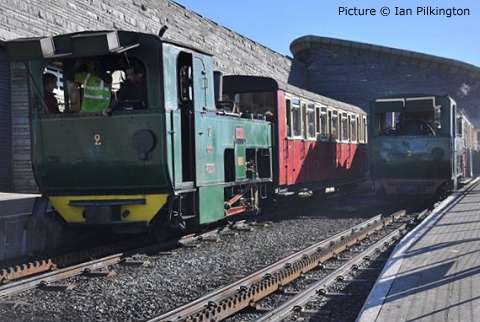
Walking the Snowdon Ranger Path on 11 October with my wife, on reaching the summit I was delighted to see two steam locos in service on the Snowdon Mountain Railway, Enid followed 30 minutes later by Wyddfa, albeit making one trip each only, all four diesels as usual working the other services. Above, Enid departs for Llanberis, Wyddfa alongside.
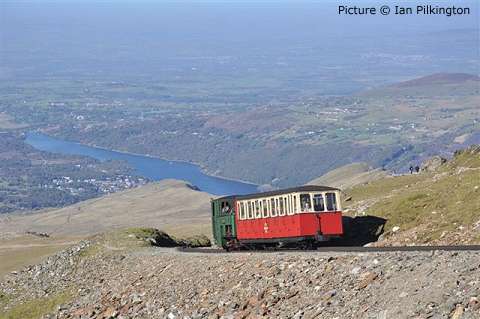
Enid descends, with Llyn Padarn in the distance.
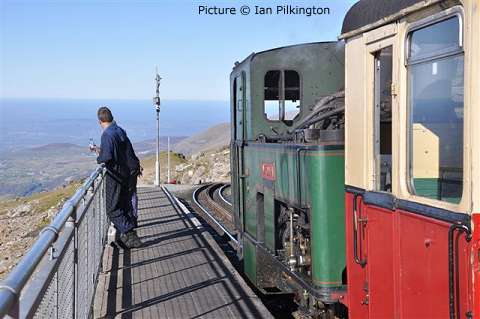
The crew of Wyddfa enjoy the wonderful view towards Anglesey and the Wicklow Hills.
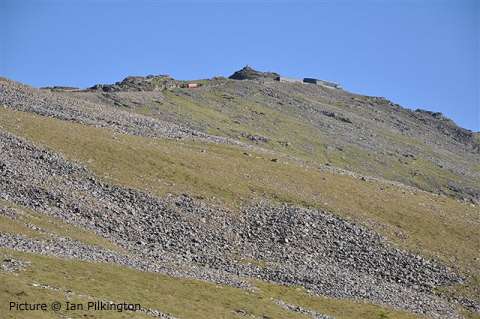
A Hunslet diesel on the final climb to the summit with the last service of the day.
A trip down south - report by Richard Fleckney
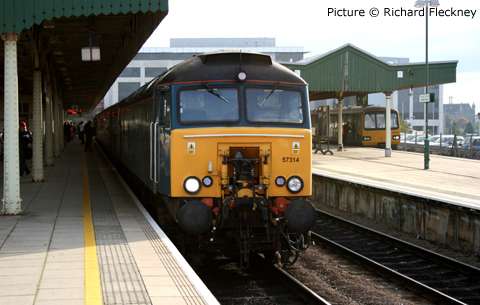
I travelled from Anglesey to Cardiff with a few friends on 21 October. The outward journey was on the early morning express, seen above on arrival at Cardiff with 57 314 in charge. The return trip to Cardiff cost £13 on the 'Club 55' scheme, plus £4.95 for breakfast on board. Complements to the on-board chef.
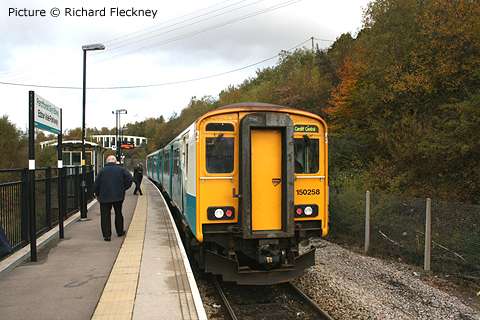
150 258 took us on a return trip on the recently-reopened line to Ebbw Vale Parkway.
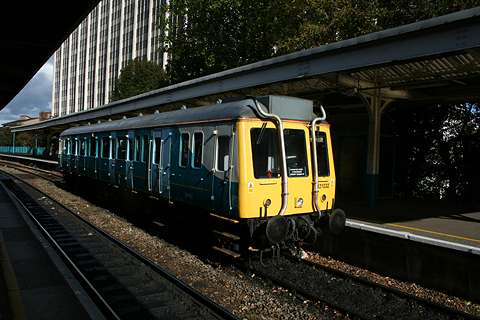
121 032 took us on its usual short trip from Cardiff Queen Street (above) to Cardiff Bay.
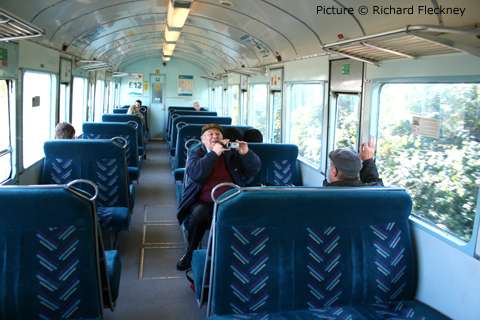
The classic DMU interior ...
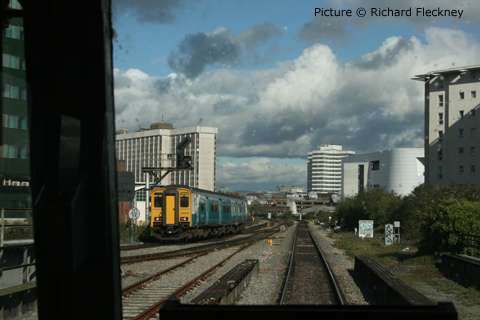
... and the view from the front as the train approaches Queen Street on the return journey.
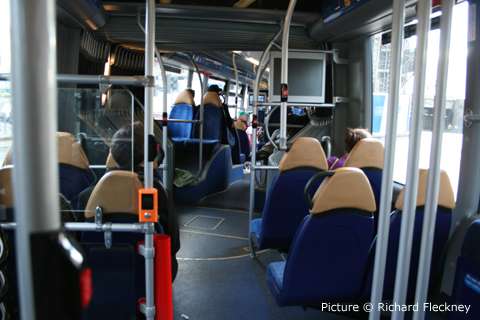
A round trip on the 'Bendy-bus' which connects Cardiff city centre and Central Station to Cardiff Bay.
Picture miscellany
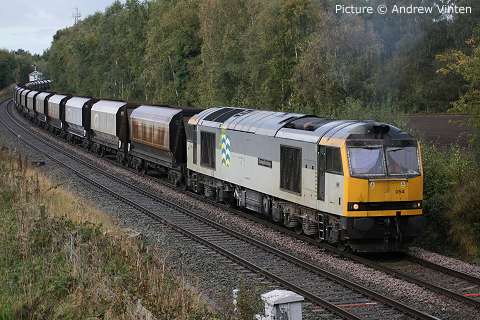
The Class 60 diesels on the Tunstead - Oakleigh stone trains continue (understandably) to attract our reporters. Above, 60 054 Charles Babbage with the 6H03 morning empties to Tunstead on 21 October recovers from a signal check at Plumley (Andrew Vinten). The hopper wagons carry the 'BM' loco of the Brunner Mond company. The original Brunner Mond & Company was formed in 1873 when John Brunner and Ludwig Mond built Winnington Works at Northwich and produced their first soda ash (sodium carbonate) in 1874. The location of the plant was ideal as the Solvay process requires salt - mined in the area - and limestone which could be obtained from the Peak District.
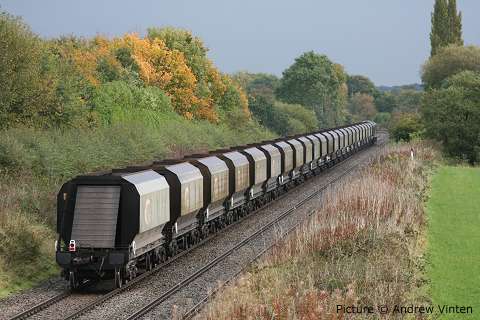
The train heads off towards Knutsford (Andrew Vinten). In 1926 the company became part of the great ICI combine, which also owned the quarry at Tunstead providing the limestone for the chemical process. For years these trains were known to all as the 'ICI hoppers' and from 1936 featured some of the first bogie hopper wagons used in the UK, eventually replaced by air-braked versions in the 1990s. In 1991, ICI was broken up again and the old company name was adopted for this operation; since 2006 Brunner Mond has been owned by the Tata group of India which also owns the Corus steel plants and seems determined to control all the UK's remaining heavy industries.
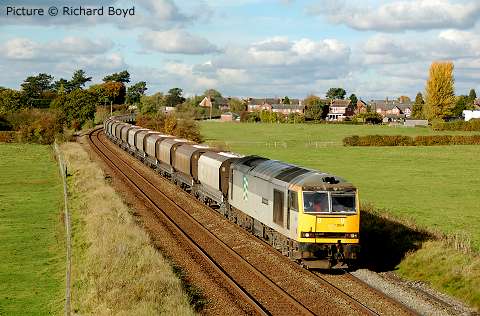
On 24 October the loaded train, 6F05, passes Ashley just before 15:00, again behind 60 054. The loco is in almost as-built condition, complete with 'sector decals' although we believe it is missing its nameplate on the other side (Richard Boyd).
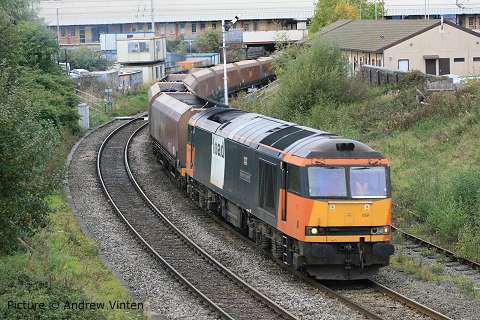
60s can also be seen on trains of imported coal from Liverpool Bulk terminal to Fiddlers Ferry power station. Andrew Vinten's picture from 21 October shows Load Haul-liveried 60 059 Swinden Dalesman with a train of returning empties (6F78) heading towards Latchford to run round before heading back to Liverpool Bulk terminal.
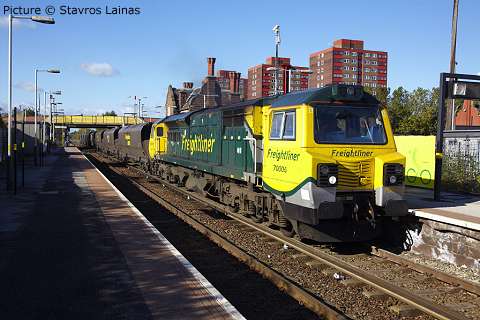
The trains feeding Fiddlers Ferry from Manisty Wharf terminal at Ellesmere Port are usually in the hands of the new Freightliner Class 70 locos, such as 70 006 seen above passing Ellesmere Port station on 20 October (Stavros Lainas).
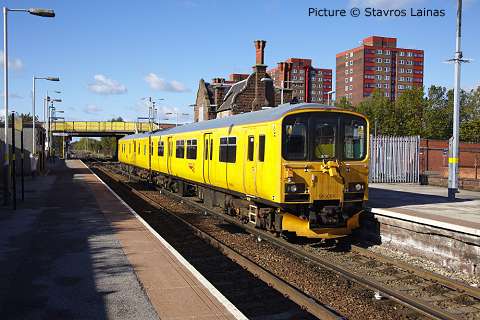
Shortly after the above scene, Network Rail's unique track recording unit 950 001 made an appearance at Ellesmere Port (Stavros Lainas)
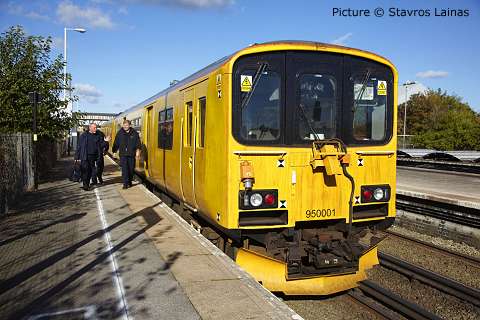
Stavros caught up with it again at Hooton soon afterwards. This unit was created by adding one to the order for Class 150s back in the 1980s, and is used on branch lines in place of the larger loco-based recording trains.
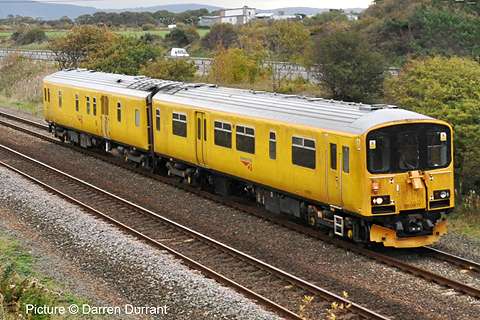
The next day the train visited North Wales, as seen at Llanddulas on 21 October (Darren Durrant)
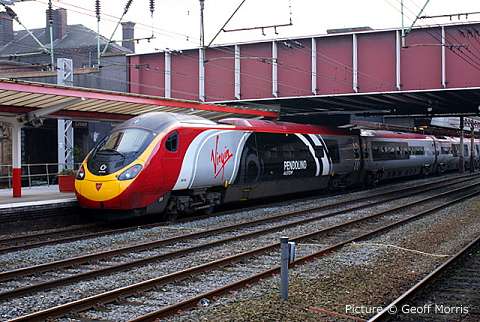
On the passenger front, Pendolino 390 004, formerly Virgin Scot, seen at Crewe on 10 October on a Euston service, is the set that was reduced to an 8-car formation following a depot mishap earlier in the year. Now that it is back in service as a 9-car set it has its livery 'tweaked' to show Alstom branding and has been renamed Alstom Pendolino (Geoff Morris).
On the Branch Line Special - report by Geoff Morris
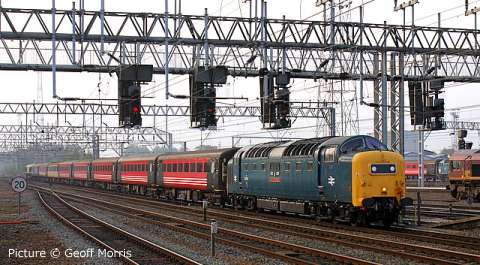
A few more pictures of the Branch Line Society Ribble-Lune special of 10 October, on which I travelled (See also the 11 October issue). Above, 55 022 Royal Scots Grey arriving at Crewe with the empty stock for the railtour.
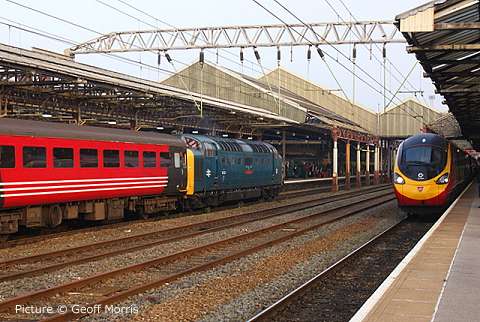
55 022 running into platform 6 while 390 004 stands in platform 5 awaiting a path south - it was delayed by over-running engineering work.
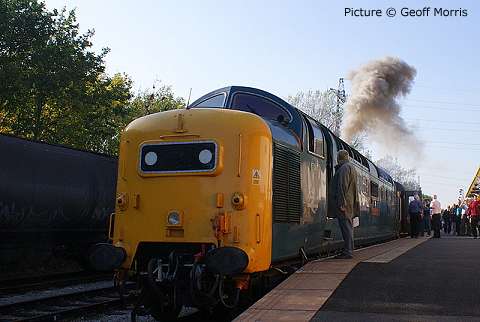
55 022 being fired up at the Ribble Steam Railway platform in Preston Docks. The Deltic has been switched off while at the rear of the train during the run between Northwich and the Ribble Steam Railway and I was hoping for a "display" when it was switched on again - I wasn't disappointed!
RCTS News - by Richard Neale
The next meeting of the Railway Correspondence and Travel Society takes place on Monday 1 November at 7.30 p.m. in the upstairs room (best reached by the stairs to the right from the main entrance) at the Lever Club, next to Port Sunlight railway station,
The evening will have Steve Ollive of Maidenhead, as the guest speaker presenting an illustrated talk entitled Plandampf 94 which features railway activity in and around Dresden and the Thuringer Forest. Visitors will be made most welcome after making a £2 donation.
Our apologies to anyone who attended our Chester meeting of 18 October and found little of direct railway interest that evening. This was due to a misunderstanding and Tony Keeley will return another time to present his Beyer Peacock show.
Telephoned enquiries about this meeting can be made to 0151 – 608 4296
Rail Head Treatment pictorial
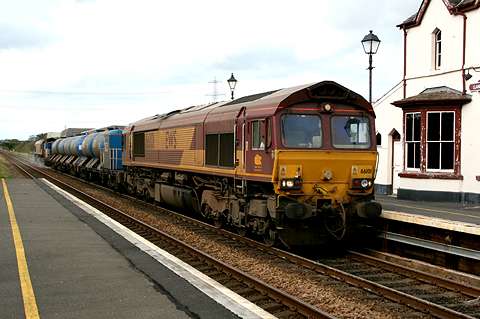
66 101 at Llanfair PG on 22 October - 66 105 on the rear (Richard Fleckney)
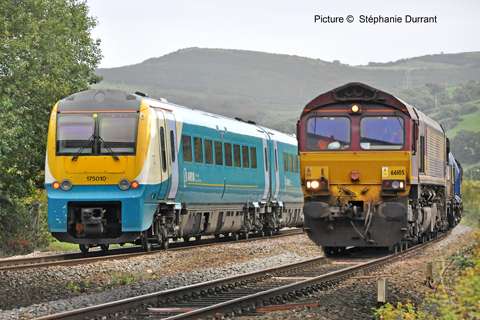
66 105 and 175 010 near Llandudno Junction, 18 October (Stéphanie Durrant)
A Friend in Steam - review by Trevor Moseley
Following recent mentions of books with North Wales railway reminiscences, there's one that hasn't been mentioned: A Friend In Steam by W.Elgar Dickinson. It describes 'One man's lifelong passion for the steam railway' beginning in the author's childhood years and relating his interest in railways, cycling and photography. The story really starts around 1945 with recollections of school trips to loco sheds and number taking, although the author is at pains to distance himself from the spotting side of things to the more serious side of photographing the working railway and particularly the locomotives seen.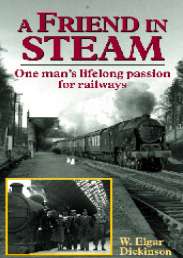 The book follows his progression through
school and on to university with
The book follows his progression through
school and on to university withsummer vacation jobs taken on the railway, mainly portering and carriage cleaning in the Leicester Great Central area, and his numerous trips around the country by cycle recording the rail scene. He records his progress from the humble box camera and his constant saving to purchase an even better camera than the last to further his hobby and the quality of his pictures.
On graduating from Durham University he took up his first teaching post at the Alun Grammar School in Mold, Flintshire. In the final chapter he chronicles his trips by train and cycle to record the North Wales rail scene in the late 1950s and, as the years progressed, to visits further afield culminating in the end of steam and his final shots witnessing the end of steam on British Rail.
All in all an enjoyable read, but it's a bit quirky when it comes to the
occasional reference to his cameras and their names! His vivid recollections of his journeys and photography point to a person who is an inveterate diarist and this is what gives the book its appeal together with the examples of his photography, which raises the question of why have we not seen more examples of his art.
Published by Silver Link Publishing from the Nostalgia Collection (paperback) 2007, reprinted 2008 and 2009. ISBN 978 1 85794 290 3. Price £9.99.
Bad day at Shrewsbury - report by Phil Brown
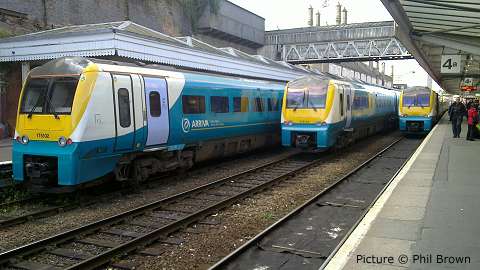
Shrewsbury was having a bit of a crisis on the afternoon of 7 October. The 14:39 to Carmarthen had 'died' in platform 4 and a Birmingham International service had been cancelled earlier in the day. Therefore platform 3 was blocked. Birmingham New Street station was also suffering a power failure. I arrived on the 13:55 from Hereford into the bay platform which was unusual considering I was on a Manchester-bound service. The train then backed out and ran through the centre road which is a tad unusual. My picture shows the Holyhead Train on No. 3, The Manchester on the through line and the dead Carmarthen train on No. 4.
It was a good half hour waiting for my train towards Pwllheli (which then suffered coolant problems and was an extra 20 minutes late). A bit later the Wrexham & Shropshire service arrived and had to wait for the ATW service to get out the way at Gobowen. So that blocked up the station again!
Engineering trains at Wrexham - report by Mark Riley
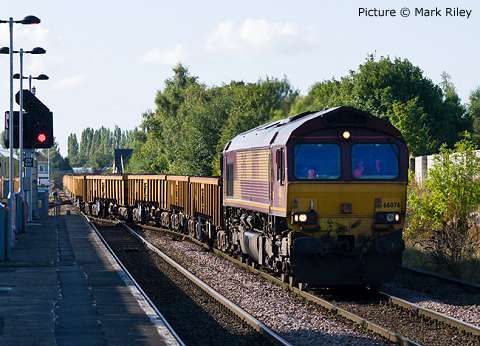
Engineering work has been intensive during the summer weekends between Wrexham and Shrewsbury and the Wirral as track improvements and relaying has taken place. Above: On 26 September, 66 076 runs through Wrexham General with a Bidston - Crewe Basford Hall working, consisting of 15 JNA wagons loaded with spent ballast.
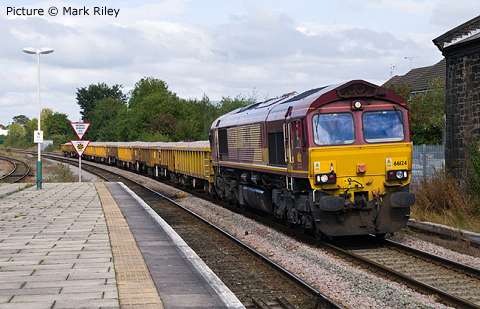
Later in the afternoon, 66 124 approaches Wrexham General on a Basford Hall-Birkenhead working, this time with just 11 JNA wagons loaded with fresh ballast.
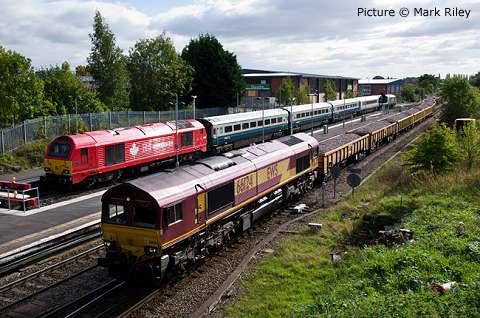
After running round at Croes Newydd, 66 124 heads up the Borderlands line, passing 67 018 Keith Heller (which had returned to working services for Wrexham & Shropshire after undergoing a recent exam), waiting in the bay at Wrexham General to work the 15:15 departure to Marylebone.
Puzzle picture solved
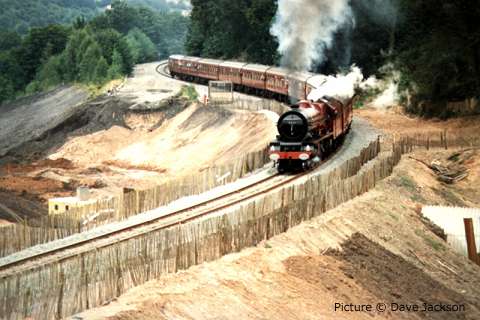
It didn't take long for answers to last issue's puzzle to appear in our inbox. Dave Jackson's picture appears again above. Congratulations to Nick Roberts who sent the correct answer at 20:18 on the same evening the page was uploaded! The location of the picture was Pont-y-capel between Gresford and Marford, during construction of the new bridge (no. 353A) over the A483 Wrexham by-pass road, and the loco is 6201 Princess Elizabeth, a popular choice for the regular 'Welsh Marches Express' in the early 1980s. Thanks to everyone who took the time to write.
Concrete Bob remembers: 'I think I was off-camera to the left of shot that day with a (huge) VHS camera. Somebody had a klaxon on board, and proceeded to sound it when they spied the camera.'
North Wales Coast home page 2010 Archive Previous Noticeboard